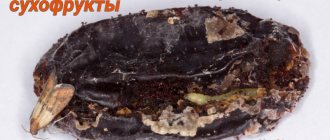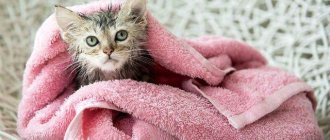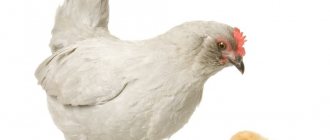Winter: wearing rules...
Mink is capricious to wear and does not tolerate neglect. For a fur coat to remain beautiful for more than one season, it must be worn correctly. And here’s what you should pay attention to before “walking” your pet.
- Freezing. Mink loves low temperatures. Therefore, a frosty day is a great reason to take a walk in your favorite fur outfit.
- Sun. Bright sun causes the color to fade. It should be avoided so that the fur does not lose its luxurious color.
- Moisture. What happens to your hair after it rains? Same as with fur. If you suddenly get caught in wet snow, get to a warm room as soon as possible, shake off the moisture and dry your fur coat at room temperature. You can’t use a hairdryer - it will dry out the pile and leather fabric.
- Dust. Dust settles on the hairs, gets clogged into the pores of the leather fabric - the fur coat quickly loses its luster and looks untidy. If it’s already frosty, but there’s not enough snow outside, and the wind raises clouds of dust, leave your fur coat at home until better times.
- Friction. It is a nightmare for a fur coat. Even with slight but prolonged pressure, the fur wrinkles. And with constant friction, it’s even worse: the guard hair breaks, the underhair gets wiped out, and ugly bald patches appear. Therefore: we carry bags exclusively in our hands and diligently avoid crowds.
- Reagents. Mink fur is very delicate and does not tolerate exposure to aggressive substances. It is better not to walk along streets treated with reagents in a long fur coat: the route should be from the entrance to the transport and back.
What to do with a damaged fur coat
If a product is clearly damaged by moths, sometimes it is still possible to return it to its “marketable” appearance. It all depends on how severe the damage is: if there are a lot of bald spots or they are quite large, you will most likely have to say goodbye to your favorite and expensive item. But minor defects can be completely eliminated, although sometimes using drastic methods:
- the easiest way is to tint the bald patch to match the fur (a more difficult one is to paint the entire product in the color of its skin so that the “bald patch” does not catch the eye);
- a small bald patch can be cut out and the edges sewn from the inside: the repair area will not be noticeable;
- If quite large “bald patches” have already appeared on the hem or sleeves, you can change the style of the item by shortening it or cutting off the sleeves.
Expensive fur items in the wardrobe are not only beauty and an indicator of wealth, but also constant work to care for them. Systematic measures to protect products from moths guarantee the furs an ideal appearance without unwanted damage.
... and conditions of detention
You also need to know how to store a mink coat in winter. To begin with, do not leave your fur coat hanging where it could be covered with other things. The fur may become deformed. Also consider four other tips.
- Do not hang the product by the loop. Only a hanger with wide hangers. Otherwise, the leather fabric will stretch and the fur coat will lose its shape.
- Do not leave near heating devices. Hot air damages the pile and the leather fabric loses its elasticity.
- Do not hang it on the balcony. Direct rays of the sun fall there, which can change the color of the product.
- Don't spray perfume. Stains may remain and the fur will lose its shine.
Prevention measures
Rub the fur with table salt, weak solutions of carbolic and salicylic acid, or creosote. This event must be carried out with poorly processed fur, otherwise in the summer, and even if stored improperly, the appearance of fly larvae cannot be avoided.
We suggest you read: How to treat wood against bark beetle
Regularly hang your fur coat, hat or vest in the sun (once a month) and fresh air, clean it from dust (shake it out). Ultraviolet light and oxygen are the worst enemies of moths and their larvae.
Store fur products in dry, dark and closed areas. At the same time, do not forget about their regular ventilation and periodic washing of the walls of the room (cabinet shelves) with carbolic acid. If things are stored indoors in a folded state, then they must be sprinkled with insecticides against insects that do not have a strong odor;
Under no circumstances should you use plastic bags or other materials that do not allow air to pass through for storing fur coats, hats, muffs. Condensation (moisture) and lack of fresh air are not only a favorable environment for the reproduction of insects, but also harm the fur;
You can regularly clean the fur (combing), and if necessary, easily beat it out, using a stiff brush. This is a mandatory measure when larvae are detected.
The last procedure on the list will be especially necessary for a mink coat for a car lady, or any similar fur product that experiences increased operating loads. Combing the skin will allow you to straighten the tangled and stuck together pile and give it the right direction. The fur will look well-groomed, and the fur coat will look as if it had just been taken from a display case.
How to store a mink coat: features of summer care
Winter is over, you can put on a fur coat and “rest.” And properly organized “hibernation” is a guarantee that the mink will meet the next season in its original form.
Cleaning methods
Proper storage of a mink coat in summer begins with cleaning. During active wear, a lot of dust, grease and dirt have accumulated on the hairs and under them, and they are literally food for moths. It is important to do this as carefully as possible so as not to damage the pile and color of the product. Professionals advise using exclusively dry cleaning services - they will select a product specifically designed for fur and treating it with the utmost care. If you decide to go this route, only contact a trusted place with good reviews.
If dry cleaning is not an option, then you can try cleaning the mink yourself. Before you start you need:
- hang the fur coat on hangers and fasten all the buttons;
- shake vigorously - by the hem, sleeves, “beat” on the back and front;
- carefully remove dried dirt using a special brush for mink care;
- remove from the hanger and shake vigorously;
- Place it on a dry, flat surface and you can begin basic cleaning.
The table describes how to do this effectively and safely.
Table - Methods for “at-home” cleaning of mink fur coats
| Recipe | How to clean |
| With starch | — Generously sprinkle starch (or talc) over the surface of the fur coat; - sweep the fur with a cotton pad against the lint; — pay special attention to the collar, pockets, sleeves and hem; - shake the fur coat vigorously several times so that all the starch comes off the fur; - repeat the procedure until the starch no longer turns gray |
| With alcohol | — Moisten a white soft cloth in alcohol or vodka; - move it against the growth of the pile, moving from the hem to the collar; - treat the entire surface in this way; - then rub in the opposite direction; - change the rag when it gets dirty; - hang the fur coat on wide hangers and let the fur dry on its own |
| With vinegar | — Mix vinegar (9%) with water in equal proportions; — soak cotton wool or cloth in the solution; - squeeze; - wipe the pile first against hair growth, and then vice versa; - hang up your fur coat; - let the fur dry at room temperature |
| For white fur | — Mix 100 ml of peroxide and water, add 5 drops of ammonia; - hang the fur coat on hangers; — spray the solution from a spray bottle evenly over the entire surface of the product; — maintain a distance of approximately 20 cm; - you don’t need to wet it too much, the fur should be slightly damp; - let the pile dry naturally |
| In case of heavy dust | - Soak the cloth in water and wring it out well; - cover the product with it; - hit the fur coat with a stick (beater) (like a carpet, only more gently); - do the same on the reverse side |
| To remove stains | - Lather a little baby shampoo on a damp sponge; - collect foam on a cotton pad; - rub the stain; - remove any remaining foam with a paper towel; - dry the fur coat |
| For “washing” the lining | — “Dip” a soft-bristled brush into the soap solution; - shake off excess moisture; - walk around the entire lining in a circular motion; - dampen a white cloth in clean water; - wipe the lining; - blot away any remaining moisture with paper towels; - hang the fur coat on hangers; - dry |
When the fur coat is completely dry, all that remains is to carefully comb the pile. It is better to use a special fur brush. They are sold in fur stores. You can also use a soft-bristled brush or a sparse comb.
Using rubbing alcohol, you can remove traces of lipstick and other decorative cosmetics from fur. If you find mascara on your fur coat, first remove it with a cotton swab dipped in cosmetic milk or micellar water, and then wipe the area with alcohol.
"Hibernation" in the closet...
The mink coat has been cleaned, dried, and now you can put it away for storage in a closet or dressing room. Conditions for summer hibernation should be as follows.
- Light. The mink “doesn’t like” him. Accordingly, the storage space should be dark.
- Humidity. High – harms the fur. In addition, dampness is an excellent environment for the growth of bacteria and fungi. And too dry air will dry out the pile and leather fabric - the fur coat will lose its elasticity and shine. Optimal humidity levels in the storage area are 50-60%.
- Space. It is necessary to organize the storage location so that other things do not come into contact with the fur coat. Otherwise, the fur will wrinkle and unsightly creases will form.
- Case. To prevent your fur coat from becoming dusty during your “rest”, place it in a special case; it is better to use a “original” one from the store. But any other will do, the main thing is that it fits in size and the material is “breathable”. It is strictly forbidden to store a mink coat in a cellophane case - it will “suffocate”. Increased humidity, mold and unpleasant odor will appear.
- Temperature. It should be as low as possible. To the extent possible in a residential setting.
- Ventilation. Since the temperature in the mink closet is too high in summer, it must be taken out of its cover and “walked” at least once a month. You can ventilate the product, for example, on the balcony in cool weather or turn on the air conditioning in the room and leave the fur coat there for several hours.
- Hanger. Must have wide shoulders. Their length should be exactly up to the shoulder seams of the product. If they are too short or long, in winter you will find stretched “bubbles” on your fur coat.
- Clasps. After hanging the fur coat on the hangers, be sure to fasten all the existing buttons, take everything out of the pockets, take the belt out of the belt loops and also hang it on the hanger. The fur coat should be perfectly straightened.
If, with the onset of cold weather, you find that the fur has become wrinkled in places and small creases have appeared, do not panic. Hold the wrinkled areas over the steam for five to ten minutes - the pile will straighten out. Just make sure that the steam jet does not touch the fur.
...and in the refrigerator
There is often an opinion on the Internet that the best way to store a mink coat is in the freezer. What does it mean? This does not mean a freezer as such, but a special refrigeration chamber for fur coats. It really is possible to create ideal conditions for storing fur products, regardless of weather conditions. This pleasure is not cheap - the price (with delivery, assembly and one-year warranty) starts from 450 thousand rubles (data as of November 2022).
If finances and the size of your home allow you to purchase such a refrigerator, great. If not, then there is a good alternative - renting space in a fur coat refrigerator. Sometimes fur salons and laundries/dry cleaners offer their clients such a service - you can deposit a fur coat for only 1,500-2,000 rubles per month (average price in Moscow as of November 2022). For an additional fee, the product will be treated with an anti-moth compound, and you don’t have to worry about your pet until the coldest weather.
Actions to take if a fur product is contaminated
First, you should find out that it is a moth that has settled in your fur coat. Since the caterpillars of this insect are always hidden and are located at the base of the pile, it is quite difficult to notice them with the naked eye. Having settled in thick fur, they weave small silk cocoons, which are replaced after each molt. The food for them is the lint; they do not touch the skin.
Signs of infection
The main sign of moths in your fur coat is individual bald spots. Empty areas indicate that the infestation is still minor. What other symptoms might there be?
- The fibers stick out in different directions, the fur is crumpled and looks sloppy.
- Hairs accumulate on the floor under the fur coat, which the caterpillar has cut off in order to move to the neighboring area.
- In places where the larvae move, the fur is crushed.
The fur coat will be most damaged where the caterpillar crawled. To saturate it, it needs a small amount of lint, and when moving, it simply cuts off the hairs that are in its path.
Even small colonies of larvae can cause serious damage to a natural fur coat.
The surest sign of fur infection is a large accumulation of butterflies in the wardrobe and caterpillars, which are already visible to the naked eye. In this case, it is necessary to take decisive steps to destroy them.
How to save the product?
Now it’s time to figure out what to do if your fur coat is eaten by a moth. Everything here will depend on the scale of the damage caused.
- If the damage is numerous, then, unfortunately, the fur coat cannot be saved and the expensive item will simply have to be thrown away.
- Small flaws and a small number of narrow “paths” can be painted over with a marker matched to the color of the pile.
- Sometimes it’s easier to dye the fur coat itself to match the color of your skin.
- One small bald spot can be hidden in a fold by cutting out the damaged area and stitching the skin from the inside.
- If the bald spot is large, but only one, then it can be hidden under a brooch or an original patch.
- If there is damage only on the hem, but you don’t want to throw away the fur coat, then you can shorten it by contacting a tailor.
How to quickly kill insects?
Modern powerful insecticides can provide a quick effect. They are guaranteed to remove moths at all stages of development from both the fur coat and the closet, without causing the slightest harm to the product itself.
Aerosols act almost instantly and after a short period of time all insects will die
The following aerosols will quickly destroy fur moths:
- Clean house;
- Antimol;
- Armol;
- Raptor;
- Extramit.
These products must be sprayed onto the fur coat, having first laid it out in a spacious room. The product should be processed from all sides, not forgetting about folds, pockets and lining material.
After this procedure, the fur coat must be packed in a case, an aerosol must be sprayed into it and left in this condition for several days.
There are several more ways to quickly get rid of moths in a fur coat:
- take the product to dry cleaning;
- take the fur coat to the sanitary and epidemiological station, where it will be treated with heat;
- hang the fur item in the sun on a hot summer day;
- put the fur coat in a plastic bag, preferably black, and place it in the first seat of a car parked in direct sunlight;
- take clothes outside in severe frost (at least -10°C).
Such a nuisance can happen to each of us when you take out your favorite fur coat from your wardrobe, and it already has a new owner - a moth that feeds on the inside of the fur coat and deposits its larvae in the pile.. So, what to do if a fur coat is eaten by a moth? Having survived the shock and calmed down a little, you need to draw up an action plan that will depend on the extent of the damage to the fur product.
How to protect fur from moths
Even if you store a mink coat in an exemplary manner, it will not save you from moths. Special tools are needed. Anti-moth measures are a mandatory step in preparing for the “non-fur” season, otherwise you risk feeding your mink to these butterflies. You can buy moth repellent in the store. They come in the following types.
- Tablets, briquettes. The cheapest and most unsafe form of salvation from moths. The composition contains naphthalene and camphor, the “aroma” from the product is unforgettable and it is difficult to remove it from the fur. It is better to put the tablets on the top tier of the cabinet.
- Plates. They have no odor, and the anti-moth effect lasts up to six months. Don't be afraid to put the record directly in your fur coat pocket.
- Sections. Plastic pendant with holes on the sides. Inside it there is a plate impregnated with an anti-moth preparation. It may smell like flowers or citrus, or it may have no scent at all. It is advisable to hang two or three such sections in the closet. You can hook it directly onto a hanger with a fur coat (inside the case).
- Aerosols. Anti-moth sprays should not be applied directly to the fur. You need to spray the composition inside the cabinet - be sure to treat all the walls, corners and ceiling. If the fur coat will be stored in a case, then you need to spray its entire inner surface.
You can turn to the “experience of your ancestors.” It is known for certain that moths cannot tolerate the smell:
- lavender;
- geraniums;
- tobacco;
- citrus fruits.
Against moths, you can make small bags of gauze and place dry orange peels, the contents of a cigarette, dried flowers there, and tie them directly to a hanger inside the case. Or simply drip geranium or lavender essential oil onto a piece of cotton wool or a scarf and put it in your fur coat pocket.
The fur industry is developing rapidly. Fur coat models become more and more interesting from season to season. But trends are an ephemeral concept. And if you expect to wear mink for more than one season, then choose a classic cut and color that will not go out of fashion next winter. You already know how to properly store a mink coat.
Video on the topic
Popular questions
When housewives purchase an expensive fur product, they may have various questions about fur moths:
- How to detect moth eggs in a fur coat? It is almost impossible to detect them. Moth eggs are so small that they are difficult to see with the naked eye. They do not exceed 0.5 mm in length. They are usually white in color and oval in shape. Under favorable conditions, larvae appear within 7 days.
- What are the signs of a moth infestation? Since the larvae cut out grooves, folds or wrinkles appear on the product. The larvae also shear off the fur, which leads to the formation of bald patches. In addition, moths are actively fluttering around the room.
- Where else can you find fur moths? Its caterpillars can be found in horseradish, cayenne pepper, saffron, bay leaves, mustard seeds, orris, opium poppy fruits, almonds, and peanut husks. In addition, this parasite can damage stuffed animals, unique zoological objects, tobacco stocks, as well as raw sheep wool.
Stages of pest development
To decide what to do if there are moths in your fur coat, you need to recognize the enemy by sight. Fur or clothes butterflies can live in a closet with clothes. The former prefer natural fur, while the latter prefer drape, cloth, wool and other natural materials. The main problem is the fact that with a lack of nutrition, both types of insects can build nests in other things. In some cases, even synthetic clothing is destroyed.
Insect development occurs in several stages:
- The imago or adult is a butterfly familiar to everyone, which indicates the presence of pests in the house.
- Eggs - caterpillars develop in them. It takes 4-6 days for the masonry to mature, it all depends on environmental conditions.
- Larva - it is in this phase that the insect causes harm to things. The only form of insects that has a powerful mouthparts, thanks to which they eat wool, lint, and fabrics in order to be able to move on to the next phase of development. The life cycle of caterpillars ranges from 1 week to 2.5 months, during which they can ruin a large number of wardrobe items.
- Pupae are a transitional stage between the larva and the imago. At this stage, the pest is wrapped in a dense silk cocoon, which maintains optimal conditions for transformation into an adult.
There are moths in your fur coat - it’s time to inspect the closet. It is necessary to find not only the butterflies themselves, but also their clutches, pupae and larvae in order to completely destroy the colony of parasites.










